|
市場調查報告書
商品編碼
1835666
IoT微控制器市場:2025-2030年IoT Microcontrollers Market Report 2025-2030 |
|||||||
本報告對物聯網微控制器 (MCU) 市場進行了詳細分析,提供了有關市場規模、主要廠商佔有率、關鍵技術趨勢以及物聯網半導體市場整體概況的全面資訊。
樣品預覽
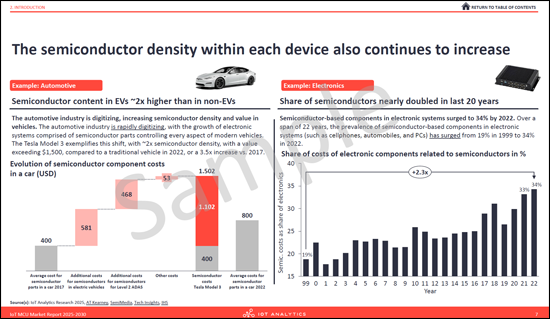
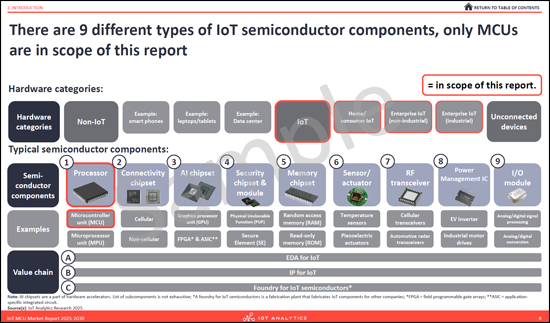

連網物聯網設備的數量持續成長,每個設備內部的半導體密度也不斷提高。物聯網設備通常包含多達九種半導體組件,其中處理器,特別是微控制器 (MCU),是關鍵元件。本報告對物聯網 MCU 市場進行了深入調查和分析,物聯網 MCU 是物聯網半導體領域的基礎類別。
本報告的主要目的是幫助讀者了解物聯網 MCU 市場的現狀,闡明其定義、規模和發展趨勢,並介紹市場預測、競爭格局、關鍵技術趨勢和最新進展。
樣品預覽

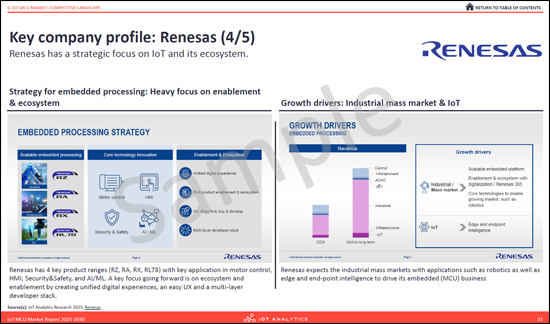
本分析是根據2024年11月至2025年7月期間進行的一手調查,包括對20多家半導體供應商和終端用戶公司的專家進行訪談。此外,也結合了二手研究和從主要產業展會中獲得的見解。
樣品預覽
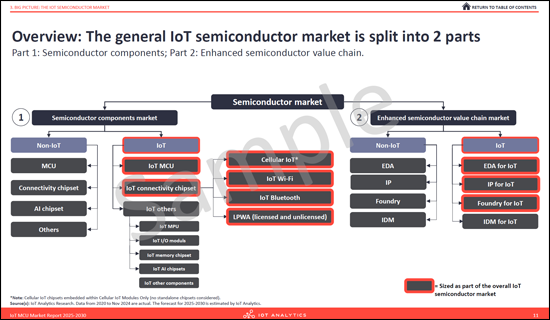
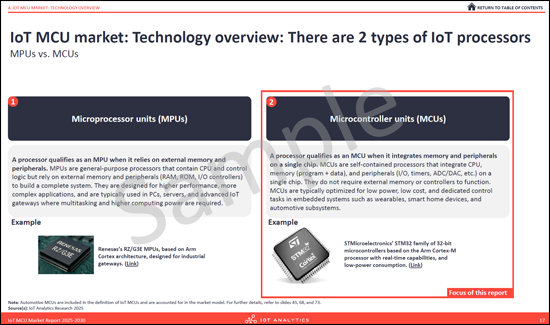
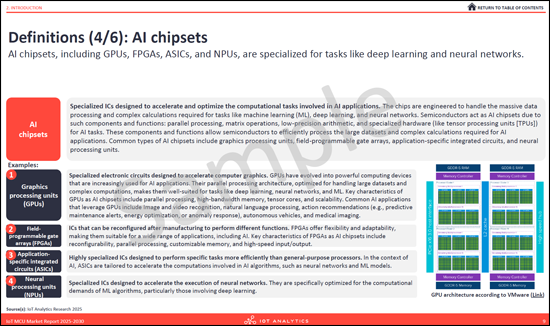
報告概要
- 91頁內容:物聯網MCU市場詳細分析,包括 2025 年至 2030 年的五年預測。
- 四大物聯網 MCU 關鍵趨勢:對改變市場結構的技術變革進行詳細分析。
- 五大半導體產業綜合趨勢:對影響整個物聯網半導體產業的因素進行全面分析,包括人工智慧、安全性和地緣政治。
- 廠商佔有率分析:對競爭格局進行細分,包括主要物聯網 MCU 廠商的市場佔有率。
- 詳細市場規模與預測:對 2030 年前各地區的市場趨勢進行詳細分析。
常見問題
- 什麼是物聯網半導體和物聯網 MCU? (物聯網半導體的定義與類型)
- 物聯網半導體中使用了哪些技術?
- 物聯網MCU市場的競爭格局如何?主要廠商的市佔率是多少?
- 物聯網MCU市場的目前規模和未來規模如何?
- 哪些區域動態正在影響物聯網MCU市場?
- 物聯網MCU領域的新興趨勢有哪些?
公司列表:
|
|
|
目錄
第1章 摘要整理
第2章 簡介
- 章概要:簡介
- 起點:物聯網連接設備的數量持續成長,預計到 2030 年將超過 400 億台。
- 每個設備內部的半導體密度也持續增加。
- 物聯網半導體元件共有九種類型,但本報告僅關注微控制器 (MCU)。
- 定義:半導體和物聯網半導體
- 定義:處理器
- 定義:連接晶片組
- 定義:人工智慧晶片組
- 定義:安全晶片組
- 定義:其他關鍵元件
第3章 透視:IoT半導體市場
- 章節概要:概覽:物聯網半導體市場
- 概述:物聯網半導體市場分為兩部分
- 第一部分:按類型劃分的物聯網半導體組件支出
- 第二部分:增強型物聯網半導體價值鏈 - 按價值鏈細分的支出
- 物聯網半導體整體競爭格局
- 物聯網對多家晶片公司的重要性
- 影響物聯網的五大趨勢半導體
- 整體趨勢 1
- 整體趨勢 2
- 整體趨勢 3
- 整體趨勢 4
- 整體趨勢 5
- 近期新半導體晶圓廠公告
- 研究方法:物聯網相關業務概況 - 台積電
第4章 IoT MCU市場:技術概要
- 章節概述:物聯網 MCU 市場 - 技術概述
- 物聯網 MCU 市場:技術概述:兩種類型的物聯網處理器
- 物聯網 MCU 市場:技術概述:MCU 與物聯網 MCU/MPU 與物聯網 MPU 的比較
- 物聯網 MCU 市場:技術概況:MPU 概述
- 物聯網 MCU 市場:技術概述:MCU 概述
第5章 IoT MCU市場:市場規模與展望
- 章節概要:物聯網MCU市場 - 市場規模與展望
- 全球半導體元件支出:MCU與其他所有元件的比較
- 全球MCU市場支出:物聯網MCU與非物聯網MCU的比較
- 全球物聯網MCU市場支出
- 分析師對物聯網MCU市場的評論
- 全球物聯網MCU市場支出:依地區劃分
第6章 IoT MCU市場:競爭情形
- 章節概要:物聯網MCU - 競爭格局
- 物聯網MCU競爭格局
- 主要公司簡介:英飛凌
- 研究方法:物聯網相關業務映射 - 英飛凌
- 主要公司簡介:瑞薩電子
- 研究方法:物聯網相關業務概況 - NXP
第7章 IoT MCU市場:主要趨勢
- 章概要:IoT MCU市場- 主要趨勢
- IoT MCU趨勢1
- IoT MCU趨勢2
- IoT MCU趨勢3
- IoT MCU趨勢4
第8章 調查手法和市場定義
- 定義
- 國家與地區的製圖
- 調查手法
- 研究方法:如何分析各公司
第9章 關於IoT Analytics
A 91-page report detailing the IoT microcontrollers unit (MCU) market, including market sizing, market shares of key vendors, leading technological trends, with an overview of the broader IoT semiconductor market.
Sample preview



The number of connected IoT devices continues to grow, and the semiconductor density within each device is also increasing. Processors, such as microcontrollers (MCUs), are one of up to nine different types of semiconductor components typically found in an IoT device. This report provides a detailed examination of the IoT MCU market, which is a foundational category within the broader IoT semiconductor landscape.
The main purpose of this document is to help readers understand the current IoT MCU landscape by defining, sizing, and analyzing the market. It includes insights on the market size and outlook, the competitive landscape, and key technological trends and developments.
Sample preview


The analysis is based on in-depth primary research, including interviews with more than 20 semiconductor experts from various vendors and end-user companies conducted between November 2024 and July 2025. This is supplemented by extensive secondary research and insights gathered from leading industry trade fairs.
Sample preview



Report at a glance
- 91-page report: Detailing the IoT MCU market with a 5-year forecast from 2025 to 2030
- 4 key IoT MCU trends analyzed: A deep dive into the technological shifts shaping the market
- 5 overarching semiconductor trends: Analysis of the macro trends affecting the entire IoT semiconductor industry, including AI, security, and geopolitics
- Vendor market share analysis: A breakdown of the competitive landscape, including market shares of leading IoT MCU vendors
- Detailed market sizing and forecast: A granular look at the IoT MCU market size through 2030, with breakdowns by region
Key areas of analysis
- IoT semiconductor market overview
- Defines nine categories of IoT semiconductor components and provides a comprehensive market size analysis for both the general IoT semiconductor market and its extended value chain, including foundries, electronic design automation (EDA), and intellectual property (IP) segments. The section also highlights five overarching trends shaping the industry-AI integration, hardware security, geopolitical rivalry, strategic national investments, and supply chain diversification.
- IoT MCU technology overview
- Differentiates between microcontrollers (MCUs) and microprocessors (MPUs), outlining the defining characteristics of an "IoT MCU." This section provides an overview of MCU technology, including various bit-architecture variants and their respective suitability for IoT applications.
- IoT MCU market size and outlook
- Presents a detailed analysis of global IoT MCU market spending, including forecasts through 2030. It contextualizes IoT MCU market growth relative to non-IoT MCUs and the broader semiconductor components market. The section also includes a regional breakdown of market trends across key global markets.
- IoT MCU competitive landscape
- Analyzes the competitive landscape for IoT MCUs, featuring market share data of leading vendors by revenue. Company profiles highlight IoT strategies, product portfolios, strategic partnerships, and R&D priorities that define competitive positioning.
- Key IoT MCU trends
- Provides an in-depth examination of four major trends: the adoption of RISC-V architectures, the role of MCUs in intelligent mobility, advancements in energy efficiency, and the integration of edge AI capabilities within MCU designs
A data-driven foundation for key business functions
- Strategy and corporate development
- Leverage the five-year market forecast, regional dynamics analysis, and assessment of overarching industry trends such as geopolitical shifts and strategic national investments, to inform long-term strategic planning and corporate growth initiatives
- Product management and marketing
- Utilize insights from the analysis of four key technology trends, the competitive landscape, and detailed company profiles to shape product roadmaps, refine go-to-market strategies, and strengthen competitive positioning
- R&D and engineering leadership
- Apply findings from the technology overview and key trend analyses to guide research and development priorities, focusing on critical innovation areas such as power efficiency, hardware security, and AI integration
- Market intelligence and competitive analysis
- Use granular market share data, detailed company profiles, and evaluations of strategic industry shifts such as the transition from component-level to system-level solutions, to benchmark performance and anticipate competitive movements
Key concepts defined
Semiconductor
A material-typically silicon-that exhibits electrical conductivity between that of a conductor and an insulator, enabling it to control electrical current flow in electronic devices and components.
IoT semiconductor
Specialized semiconductor-based components that provide the core functionality and connectivity of IoT devices, including processing, communication, sensing/actuating, power management, and security. The report categorizes these components based on their intended use at the "design stage" of a product's life cycle.
Microcontroller unit (MCU)
A processor qualifies as an MCU when it integrates memory and peripherals on a single chip. MCUs are self-contained processors that integrate CPU, memory (program + data), and peripherals (I/O, timers, ADC/DAC, etc.) on a single chip. They do not require external memory or controllers to function. MCUs are typically optimized for low power, low cost, and dedicated control tasks in embedded systems such as wearables, smart home devices, and automotive subsystems.
IoT MCU
An MCU qualifies as an IoT MCU when it has integrated wireless connectivity (e.g., Wi-Fi, Bluetooth, ...). IoT MCUs are typically optimized for ultra-low power consumption and typically embed hardware-based security features; however, some may rely on software-based mechanisms to secure lightweight data processing tasks in IoT devices.
Questions answered:
- What are IoT semiconductors and IoT MCUs (i.e., definition and types of IoT semiconductors)?
- Which technologies are used for IoT semiconductors?
- How does the competitive landscape for IoT MCUs look like and what are the market shares of leading vendors?
- What is the current and forecasted market size for the IoT MCU market?
- What regional dynamics shape the IoT MCU market?
- What are the emerging trends in the IoT MCU space?
Companies mentioned:
A selection of companies mentioned in the report.
|
|
|
Table of Contents
1. Executive summary
2. Introduction
- 1. Chapter overview: Introduction
- 2. Starting point: The number of IoT connected devices continues to grow Expected to surpass 40 billion by 2030
- 3. The semiconductor density within each device also continues to increase
- 4. There are 9 different types of IoT semiconductor components, only MCUs are in scope of this report
- 5. Definitions (1/6): Semiconductors & IoT semiconductors
- 6. Definitions (2/6): Processors
- 7. Definitions (3/6): Connectivity chipsets
- 8. Definitions (4/6): AI chipsets
- 9. Definitions (5/6): Security chipsets
- 10. Definitions (6/6): Other key components
3. Big picture: The IoT semiconductor market
- 1. Chapter overview: Big picture: The IoT semiconductor market
- 2. Overview: The general IoT semiconductor market is split into 2 parts
- 3. Part 1: IoT semiconductor components Spending by type
- 4. Part 2: Enhanced IoT semiconductor value chain - Spending by value chain segment
- 5. Overall IoT semiconductor competitive landscape
- 6. Importance of IoT as a segment within several chip companies
- 7. 5 overarching trends impacting IoT semiconductors
- 8. Overarching trend 1 (3 parts)
- 9. Overarching trend 2
- 10. Overarching trend 3 (2 parts)
- 11. Overarching trend 4 (4 parts)
- 12. Overarching trend 5 (2 parts)
- 13. Recent announcements for new semiconductor plants
- 14. Methodology: Mapping IoT-related business - TSMC
4. IoT MCU market: Technology overview
- 1. Chapter overview: IoT MCU market - Technology overview
- 2. IoT MCU market: Technology overview: There are 2 types of IoT processors
- 3. IoT MCU market: Technology overview: MCUs vs IoT MCU/MPUS vs IoT MPU
- 4. IoT MCU market: Technology overview: MPU overview
- 5. IoT MCU market: Technology overview: MCU overview
5. IoT MCU market: Market size and outlook
- 1. Chapter overview: IoT MCU market-Market size and outlook
- 2. Global semiconductor component spending: MCUs vs all other components
- 3. Global MCU market spending: IoT MCUs vs non-IoT MCUs
- 4. Global IoT MCU market spending
- 5. Analyst commentary on the IoT MCU market
- 6. Global IoT MCU market spending by region
6. IoT MCU market: Competitive landscape
- 1. Chapter overview: IoT MCU-Competitive landscape
- 2. IoT MCU competitive landscape (3 parts)
- 3. Key company profile: Infineon (4 parts)
- 4. Methodology: Mapping IoT-related business - Infineon
- 5. Key company profile: Renesas (5 parts)
- 6. Methodology: Mapping IoT-related business - NXP
7. IoT MCU market: Key trends
- 1. Chapter overview: IoT MCU market - Key trends
- 2. IoT MCU trend 1
- 3. IoT MCU trend 2 (2 parts)
- 4. IoT MCU trend 3
- 5. IoT MCU trend 4 (2 parts)
8. Methodology & market definitions
- 1. Definitions
- 2. Country mappings to regions (3 parts)
- 3. Research Methodology
- 4. Methodology: How individual companies were analyzed










